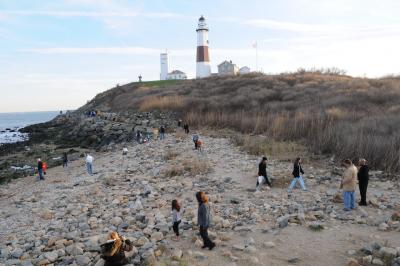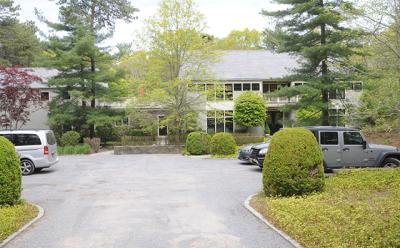Cheers, Jeers at Lively Planning Workshops
Cheers, Jeers at Lively Planning Workshops

A series of planning sessions to chart the future of East Hampton Town’s five hamlets began last week, with Springs and Wainscott leading the charge.
Unlike the town’s other hamlets, Springs has no central business district, so consultants working on the plans had to broaden their scope to include the places where people go for services and through which they must travel. They had also realized after initial discussions that residents were “really concerned about wider issues, like water and taxation,” said Peter Flinker of Dodson and Flinker, one of the firms hired by the town to learn “what you’d like us to explore, and where there are particular opportunities,” and to hear about “areas of agreement and disagreement. We’re not here to give you some preconceived notion of what you need,” Mr. Flinker said.
Springs has other unique factors, the consultant said in presenting its demographics last Thursday. Of all the hamlets, Springs saw the greatest increase in population between 2000 and 2010, a 33-percent jump, and has the largest number of residences occupied year round, at just over 53 percent. The population, according to a 2014 count, is 5,855, larger than any other hamlet’s. While it has numerous recreational sites, Springs is the hamlet with the second-lowest amount of open space.
Home prices have risen by 215 percent in Springs since 1999, but the median family income has gone up only 43 percent. The hamlet, because of the lack of commercial zoning and the number of students in the Springs School, has the highest tax rate in the town. Under current zoning, 1,677 more housing units could be built.
Traffic statistics startled many at the meeting: 16,371 vehicles a day were counted at the southwestern end of Three Mile Harbor Road near East Hampton Village, not far from the 18,930 vehicles a day logged on the Montauk Highway in Wainscott.
Residents of the community spoke up in a strong chorus last Thursday against inviting more growth or changing the character of their hamlet. The consultants presented some options, including plans for safe walking and bike routes, reshaping the hamlet’s limited neighborhood business area over time, and creating a maritime walking district at the head of Three Mile Harbor.
By connecting the area to trails going to and through the nearby Lester preserve at Soak Hides, “there’s a real opportunity to make a wonderful public park where you can walk around,” Mr. Flinker said.
Harry Dodson, Mr. Flinker’s partner, outlined some possible new uses for the Bistrian sand pit off Springs-Fireplace Road, just outside the Springs border. It could provide a parking area for contractors whose work trucks are now based in residential neighborhoods, a subject of recent conflict and several attempts at legislation to limit it. It could also offer space to more construction-related businesses, so contractors could get supplies without traveling into town, reducing Continued from A1
traffic on the roads, Mr. Dodson said.
Potential modifications to streets in order to accommodate bike paths and sidewalks prompted an extended discussion.
“It would be really nice to know that I could enjoy my neighborhood without taking my life in my hands,” said Kristi Hood, the Springs General Store’s proprietor. Bike paths would also serve many community members whose bicycles are their primary transportation, she said.
But another speaker questioned whether biking routes would be used by permanent residents or mostly by part-timers or visitors, and others said that widening the streets would create an undesirable urban or suburban look, though it was agreed that traffic and pedestrian safety was a concern.
The cluster of commercial entities on Fort Pond Boulevard near Springs-Fireplace Road came in for prolonged discussion. Describing the cluster as “a variety of different uses” in buildings that are “a hodgepodge of architectural styles . . . not too well laid out,” Mr. Flinker suggested that “it doesn’t work very well functionally, in terms of circulation, and it doesn’t look very good.”
“What can these places evolve into?” he asked. “How can they be better? Should they grow, and if they do grow what should they grow into?”
He showed a drawing depicting a possible reconfiguration of the stores and other businesses. It drew immediate negative reaction.
“We like it the way it is.”
“No, we don’t want it.”
“We’re going to have mini-malls,” people called out. “It’s not Springs.”
The town could adopt a master plan for the area with a commercial “node,” Mr. Flinker said, where residents could gather and avail themselves of services. It would provide for off-street parking and other aesthetic improvements, he said. “All of that is possible with forethought. It’s not likely to happen if we don’t think about it.”
But some were mistrustful. “This is increasing the commercial footprint, and I don’t want that,” one person said.
“The intent is not to expand the commercial development. It’s only to encourage a higher level of design,” said Mr. Flinker. The drawing he displayed was only to illustrate that idea, he said, and not a specific proposal. “You already have them, and they’re not going anywhere,” he said, but the question is, “Do you have a desire to guide the character of future development?”
“I think being open-minded, not just saying we want what it always was . . . I think we need to think outside the box, instead of just saying it’s going to stay the way it is, because it’s not,” said Ms. Hood. “We have the opportunity to set the pattern for the future. You could get out of your car and walk to one or two shops.”
Rameshwar Das agreed that changes should be considered. “I think what is there is dangerous, dysfunctional, it’s ugly, and it’s pretty disjointed, and it would be very nice to improve it.”
“Wouldn’t it be nice . . . getting a cup of coffee, having a seat,” M.J. Arceri said. “It doesn’t have to be cookie-cutter.”
An “emerald necklace” concept, creating links among trails through the hamlet and beyond, was more generally acceptable. “What we’re trying to do is really create a robust network that connects every neighborhood with key destination centers,” Mr. Flinker said.
Elements of the Springs economy under consideration, he said, include the number of home-based businesses in the community, whether permitted or under the radar.
In sessions on Wainscott Friday and Saturday, a desire to create a more inviting feeling and a community identity along Montauk Highway came to the fore. Residents worked with the consultants on how to create a more inviting, walkable hamlet center along the highway, akin to the downtowns in other hamlets, using models and large maps of Wainscott buildings.
Planting streetside trees and creating more parking behind the strip of highway businesses, with walkways for pedestrians, were among ideas that everyone seemed to agree upon. The post office could be incorporated into the concentration of businesses on the north side of the highway for more of a village feel, it was suggested.
“Form-based codes” that control the architecture and configuration of buildings, and how they relate to the street, could help to shape Wainscott’s future look, Mr. Flinker said. Design ideas can be incorporated into zoning and other town legislation “so it ends up being what you want instead of just a hodgepodge,” he said.
The acreage at the Wainscott “pit,” the site of Wainscott Sand and Gravel — which is privately owned but primarily undeveloped — could present a problem-solving opportunity and a space for a mixed-use village area that could include housing, he said. And perhaps the landowner, John Tintle, could be convinced to replace some of the industrial uses on the land if the community came up with an “exciting” proposal.
The redevelopment of the former Star Room nightclub property, where a car wash has been proposed, is of concern to many in Wainscott, participants said. Perhaps the town could enact a short-term development moratorium until the hamlet plan is completed, Sara Davison suggested.
“This will be an incremental revolution,” Mr. Flinker said. “A lot will be done by private [entities] working within guidelines. You’re really shaping the DNA that’s going to guide the growth of this place over the next 50 years. We don’t know how fast it will happen, but we know that you can shape it.”
Incorporating data from traffic, economic, and other analyses, the consultants will prepare draft hamlet plans for presentation to the town board in several months, after which public discussion will resume. Comments can be sent to [email protected]
Public planning sessions focusing on East Hampton will begin on Wednesday at 2:30 p.m. with a walking tour, meeting in front of the North Main Street I.G.A. It will be followed with a 6:30 p.m. discussion that night at the East Hampton Post of the American Legion, on the highway in Amagansett, and a presentation of ideas, also at the Legion, next Thursday night at 6:30.
Sessions on Amagansett will begin on Friday, June 3, with a walking tour leaving from the Amagansett Library at 10:30 a.m., followed by a 6:30 p.m. public workshop at Legion Hall, and a workshop there from 9 a.m. to noon on








